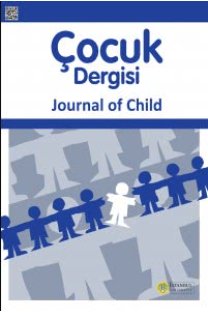Yenidoğanın Geç Başlangıçlı Sepsisi
Yenidoğan, geç sepsis, infeksiyon, menenjit
Late-Onset Sepsis in Neonates
Neonate, late-onset sepsis, infection, meningitis,
___
- 1. Çelebi S, Hacımustafaoğlu M. Yenidoğan sepsisi ve bebek ölümleri. ANKEM Dergisi 2007;21:101-7.
- 2. Saez-Llorens X, McCracken GH. Perinatal bacterial diseases. In: Feigin RD, Cherry JD, Demmler GJ, et al (eds): Textbook of Pediatric Infectious Diseases 5th ed. Philadelphia, Saunders, 2004, 929-6.
- 3. Edwards MS, Baker CJ. Sepsis in the newborn. In: Gershon AA, Hotez PJ, Katz SL (eds): Krugman’s Infectious Diseases of Children 11th ed. St Louis: Mosby, 2004, 545-61.
- 4. Stoll BJ. Infections of the newborn infant. In: Behrman RE, Kliegman RM, Jenson HB (eds): Nelson Textbook of Pediatrics 17th ed. Philadelphia, Saunders 2004, 623-40.
- 5. Ilıkkan B. Yenidoğan sepsisi. Türkiye Klinikleri, J Pediatr Surg-Special Topics 2010;3(1):15-8.
- 6. Türkiye’de neonatal sepsis nedenleri. Türk Neonatoloji Bülteni 2009;20:28.
- 7. Estripeaut D, Saez-Llorens X. Perinatal bacterial diseases, “Feigin RD, Cherry JD, Demler-Harrison GJ, Kaplan SL (eds): Feigin and Cherry’s Textbook of Pediatric Infectious Diseases, 6th edition, Philadelphia, Saunders Elsevier, 2009, 979-1020.
- 8. Haque KN. Definitions of bloodstream infection in the newborn, Pediatr Crit Care Med 2005;6:45-9. http://dx.doi.org/10.1097/01.PCC.0000161946.73305.0A PMid:15857558
- 9. Palazzi DL, Klein JO, Baker CJ. Bacterial sepsis and meningitis, “Remington JS, Klein JO, Wilson CB, Baker CJ (eds): Infectious Diseases of the Fetus and Newborn Infant, Philadelphia, Saunders Elsevier, 2006, 247-96.
- 10. Weisman LE. Coagulase-negative staphylococcal disease: emerging therapies for the newborn and pediatric patient, Curr Opin Infect Dis 2004;17:237-41. http://dx.doi.org/10.1097/00001432-200406000-00011 PMid:15166827
- 11. Yalaz M, Çetin H, Akisu M, Aydemir Ş, Tunger A, Kültürsay N. Newborn nosocomial sepsis in a level-lll NICU: evaluation of the causative agents and antimicrobial susceptibilities, Türk J Pediatr 2006;48:13-8.
- ISSN: 1302-9940
- Yayın Aralığı: 4
- Başlangıç: 2000
- Yayıncı: İstanbul Üniversitesi
Hipohidrotik Ektodermal Displazi ve Gastroözofageal Reflü Hastaliği: Vaka Sunumu
Mahya Sultan TOSUN, Vildan ERTEKİN, Mustafa BÜYÜKAVCI, Hakan DÖNERAY
İlk Altı Ayda Anne Sütü ile Beslenmeye Etki Eden Faktörler
Fatih BOLAT, Sinan USLU, Güher BOLAT, Ali BÜLBÜL, Selda ARSLAN, Muhittin ÇELİK, Serdar CÖMERT, Asiye NUHOĞLU
Non-Ketotik Hiperglisinemi: Vaka Sunumu
Mehmet MUTLU, Yakup ASLAN, Berna SAYGIN
Akut Romatizmal Ateşte Görülen Ender Bir Ritim Bozukluğu: Supraventriküler Taşikardi
Yakup ERGÜL, Hülya MARAŞ, Kemal NİŞLİ, Ümrah AYDOĞAN, Aygün DİNDAR, Rukiye EKER ÖMEROĞLU
Uzun Süreli Total Parenteral Beslenme Sonrası Wernicke Ensefalopatili Bir Vaka Sunumu
Mustafa KÖMÜR, Gökhan GÜNDOĞDU, Dinçer AVLAN, Çetin OKUYAZ
Yenidoğanın Geç Başlangıçlı Sepsisi
Muhittin ÇELİK, Emrah CAN, Fatih BOLAT, Serdar CÖMERT, Ali BÜLBÜL, Sinan USLU
Betül POLATDEMİR EMEK, Lida GÜNEŞ BÜLBÜL, Nazan ALTINEL, Sami HATİPOĞLU, Ali BÜLBÜL
Murat SÜTÇÜ, Ayşe KILIÇ, Emin ÜNÜVAR, Nelgin GERENLİ, Muhammet Serdar CANTEZ, Işıl ÖZER, Fatma OĞUZ, Müjgan SIDAL, Gülden GÖKÇAY, Özlem DURMAZ
Çocuk Hastaların Hastane Yatışları Sırasında Gelişimlerinin Desteklenmesi
